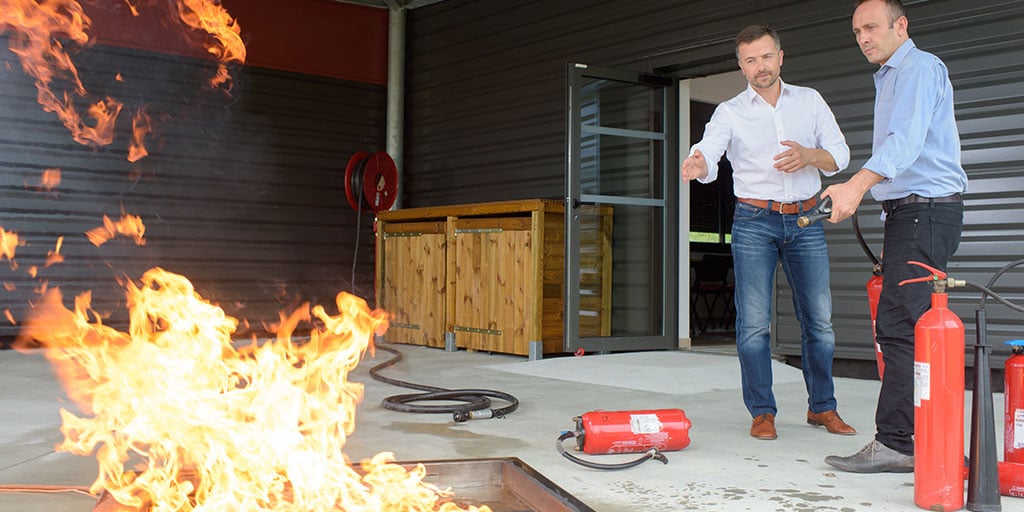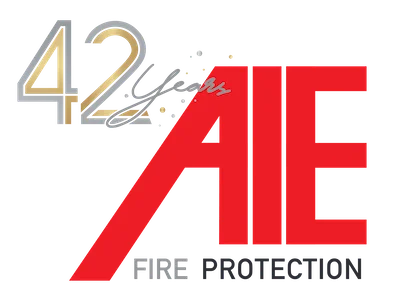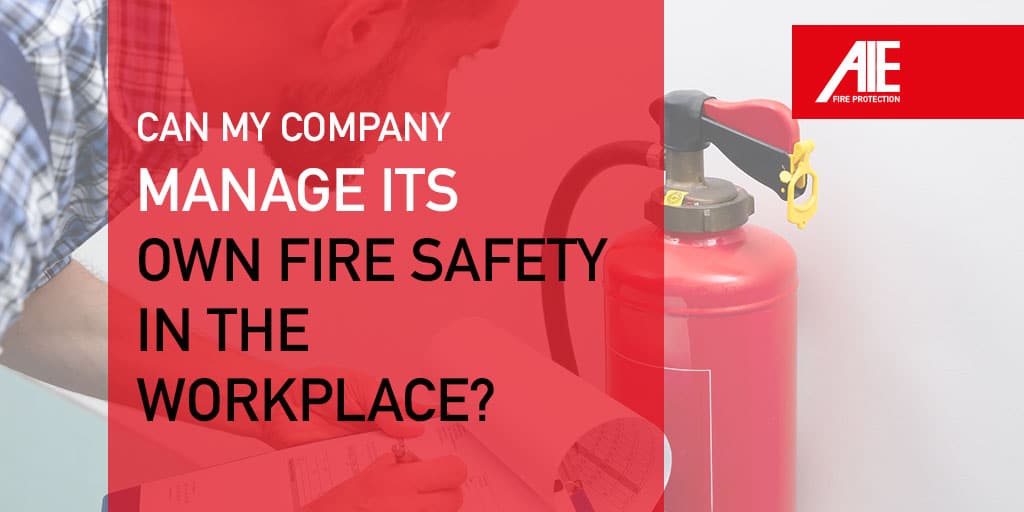To an owner or a manager of a retail shop or big box store, restaurant, or office complex, fire safety requirements can be confusing. It can be difficult to determine just who is responsible for fire protection and fire safety in the workplace and what can be managed internally. Understanding the different aspects of fire prevention in the workplace is important.
Fire Safety in the Workplace I Can Manage
Because of this, we get asked often, “Can my business manage its own workplace fire safety program?” The answer to that is Yes and No. To get a handle on what fire safety you can DIY and what must be managed by a licensed fire protection company, AIE has compiled this quick fire-safety guide to help make it clear. Learn who is responsible for fire safety in the workplace below.
#1 – DIY Fire Prevention Plan & Training
Most likely, you already know that OSHA fire safety regulations require employers with ten or more employees to develop a written fire safety and prevention plan that should be reviewed with all new employees and made available to existing employees at any time. (If you have fewer than ten employees, you may communicate the plan verbally).
Put simply, your OSHA fire prevention and safety plan is compiled by you and specific to your company. It must:
- Explain how everyone can prevent fires.
- Detail what to do if there is a fire.
- Include all emergency procedures.
- Designate fire watch/fire safety personnel.
- Define fire escape routes.
Work the plan. Your workplace fire prevention and fire safety plan should be reviewed and updated annually, practiced with evacuation drills, and managed by designated staff members, according to OSHA rules, National Fire Protection Association (NFPA) Standards, and your local Authority Having Jurisdiction (AHJ).
Train all employees and appoint fire safety personnel. OSHA requires you to train each new employee at the time of hire and existing staff annually on your fire prevention and safety plan. Additionally, it is recommended that you appoint fire watch employees, evacuation managers, and those who stay behind to shut down critical equipment. It’s imperative your staff understands how to prevent fire hazards in the workplace.
Prevention. The best thing you and your employees can do to minimize fire risk is to make fire safety and prevention in the workplace part of your daily routine. Here are the steps that should be outlined in your plan:
- Keep flammable items such as paper, clothing, and chemicals away from electrical outlets, flames, and static electricity.
- Keep exit areas free of debris and keep smoldering cigarettes away from trash receptacles and other flammables.
- Designate smoking areas away from any hazards and use proper ash receptacles to ensure cigarettes are not burning when discarded.
- Maintain cleanliness, especially in areas where there are cooking appliances, and assign break room checkers to ensure all ovens, toasters, coffee machines, hot plates, etc., are off/unplugged at the end of the day or per shift.
Fire safety in the workplace is everyone’s responsibility. Knowing those responsibilities and taking the proper actions can help prevent fire, protect your business, and save lives.
Emergency planning and training directly influence the outcome of an emergency situation. Facilities with well-prepared employees and well-developed preparedness plans are likely to incur less structural damage and fewer or less severe employee injuries. – NFPA

#2 – DIY Inspections for Fire Protection Systems in the Workplace
While there are standard time frames for each inspection, the more often you inspect your fire systems the better. Your company is entitled to conduct your own weekly, bi-weekly, and monthly fire-safety inspections and analysis, such as fire sprinkler and portable fire extinguisher inspections. A staff member trained in the proper NFPA25 Standards and local code compliance may perform weekly and monthly inspections on the following:
- Utilities and equipment
- Visual inspections only for fire sprinkler systems
- Visual inspections only for fire suppression systems
- Visual inspections only for portable fire extinguishers
- Visual inspections and cleaning of kitchen hood suppression systems
Inspect Utility & Fire Protection Equipment
Make inspections, and repair and maintenance of electrical wires, gas lines, plumbing, utility connections, and all fire protection equipment part of your regular routine to ensure they don’t become a fire hazard and that they work when needed.
Also, keep flammables away from running electrical and gas appliances, the furnace or air conditioner, overheated motors, machinery, or even smoldering cigarette butts. Fire load can remain low in clean, uncluttered work areas.
Inspect Fire Sprinkler & Suppression System
When it comes to your company’s fire sprinkler and/or fire suppression system, a trained employee should check for normal air and water pressure on the dry, pre-action, and deluge systems gauges weekly. He or she will also make sure control valves are not leaking or locked, that they are sealed and open.
Monthly, your on-site fire protection person should look at the wet pipe systems gauges, confirm water pressure is maintained and that there are no signs of physical damage. Alarm valves should also be inspected for physical issues.
Inspect Fire Extinguishers & Provide Training
Portable fire extinguishers and their maintenance are crucial to fire safety. If your company provides them, OSHA and NFPA require monthly inspections to ensure the gauge is on full (needle to green), the hose is intact, the pin is securely in place, and there is no canister damage. These inspections can be performed by a qualified employee who then initials and dates the backside of the tag.
It is also imperative that fire extinguishers are within easy reach, no more than 75’ feet travel distance in any given direction, and that everyone is trained on where they are and how to use them. Employee training on the proper operation of the equipment is required at least once per year.
Clean & Inspect Kitchen Hood Suppression System
If you have a restaurant or a business with a commercial kitchen that uses a hood suppression system, we recommend your staff clean the hood, filter, and nozzles frequently – weekly, monthly, or bi-monthly. The fusible links that accept the heat and activate the fire suppression system will not work with a grease build-up. This do-it-yourself cleaning should be done often to prevent potential fires.
If your restaurant is high-volume, clean the hood and nozzles daily. This stops grease from accumulating and dirt from sticking to it and keeps it from collecting in the flue. These simple tasks can decrease the likelihood of hood fires and keep your kitchen running safely.

Workplace Fire Safety Training Ensures Fire Prevention in the Workplace
There is a lot of employer/employee responsibility in DIY fire prevention and training. Proper fire safety training in the workplace is at the heart of it. There are several ways to train your employees and those designated fire safety ambassadors. You can:
- Appoint an internal person who in charge of training.
- Utilize online courses.
- Hire an OSHA safety instructor.
- Request a customized training program from your fire protection and safety company.
After a thorough assessment of your building, business, and commercial fire protection systems, a custom fire prevention and safety training program can be developed for your specific needs and designed in accordance with all OSHA, NFPA, and AHJ requirements and standards. AIE develops workplace fire prevention and safety training programs for many of our nationwide clients. High-quality fire safety and evacuation training programs will save lives, money and potentially your business.
What Must Be Performed by a Fire Protection Company?
Most commercial fire safety and protection systems require quarterly, annual, and five- and ten-year fire inspections, along with testing, maintenance, and repairs. These must be performed by a licensed fire protection technician who retains comprehensive records for a minimum of one year, preferably electronically, and has the ability to produce these records when requested. The following must be performed by licensed specialists to ensure fire prevention in the workplace:
- Fire sprinkler/suppression systems
- Water supply testing, inspections, repair
- Fire extinguisher recharges/repair
- Water storage tanks
- Backflow preventer inspections/repair
- Kitchen hood suppression systems
- Fire alarm monitoring
Fire Sprinkler/Suppression Systems
The adopted codes require all commercial entities and nonprofit organizations follow NFPA 25 Standard for the Inspection, Testing, and Maintenance of Water-Based Fire Protection Systems. Each local AHJ may also have additional requirements. The general rule, as noted previously, is that fire sprinkler and fire suppression systems inspections must be performed by a licensed technician quarterly, annually, and every five- and ten-years, along with testing, maintenance, and repairs. Be sure to check with your local fire marshal for specifics.
Water Supply Testing
Without adequate water supply, your fire sprinklers may not perform as they should to extinguish a fire. Water supply testing is not something you can do on your own, and though it is not “required”, water supply testing is the most important factor in any fire protection system. The right quantity of water and effective water pressure must be available to run the system.
Businesses who utilize a fire safety company like AIE for water testing services realize cost savings as a result of the investigation and discovery of correctable problems on city supplies that may have otherwise led to significant company costs and inconveniences.
Backflow Preventer Testing & Inspection
Backflow preventers are required by law to avert drinking water contamination. Most likely, your business has at least one commercial backflow prevention device located within the water pipes to ensure water only flows one way, preventing “backflow.” It is imperative that it remains in working order to protect your customers, staff, and community.
According to the Certified Commercial Property Inspectors Association (CCPIA), the EPA holds each municipality accountable for its own water purity, therefore commercial backflow preventer testing requirements may differ slightly by region, however, typical inspection requirements include the following:
- When your backflow prevention assembly is first installed by a licensed plumber, it should be tested by that person.
- There should be an annual inspection/test of each cross-connection control and backflow preventer by a certified backflow prevention inspector.
- Repairs can only be conducted by a licensed plumber or certified backflow prevention inspector.
Kitchen Hood Systems
NFPA 96 says you must have your kitchen hood fire suppression system inspected every six (6) months by a licensed fire protection company. This ensures that if there is a kitchen stove or fryer fire, your fire suppression system will activate, put the fire out, and shut off the gas line or electricity running to the equipment.
If you need fire system inspections, repairs, or maintenance, reduce liability by partnering with AIE, an experienced, nationwide company with reliable licensed technicians, electronic record keeping and data storage, and a satisfaction guarantee.
Fire Alarm Monitoring
Fire alarm monitoring is not something you can DIY. When a fire alarm goes off in your restaurant, hotel, retail store, or office building, a monitoring device assesses the signal to rule out a false alarm and instantly transmits the emergency to first responders. The fire department can be on its way often before a person can call 911 or physically get help, especially when trapped by a fire.
24/7 fire alarm monitoring requirements vary from building to building and state to state. To determine whether you need it and what type you need, you can ask a professional fire protection company or your local Authority Having Jurisdiction (AHJ).

DIY Fire Protection vs. Outsourcing Your Fire Safety in the Workplace
Fire prevention and fire safety in the workplace are crucial to the safety of your employees, visitors, and other occupants, as well as to the longevity of your business. Though much of it can be a DIY practice, outsourcing fire systems inspections, testing, maintenance, and repairs to a reputable fire protection company reduces your liability and increases life safety while ensuring your business stays operational.
Contact AIE to learn how we can streamline your fire prevention in the workplace for big box stores, retail chains, grocery stores, hotels, warehouse distribution centers, and other multi-site commercial facilities, and minimize fire risk with reliable workplace fire safety systems and prevention. 800-892-9863
Information posted in our blog is merely for educational and informational purposes. While the information has been verified to the best of our abilities, we cannot guarantee its total accuracy, and it should not be considered legally binding advice. This blog is not intended as a substitute for professional advice, and should you decide to act upon the information, you do so at your own risk.


Recent Comments